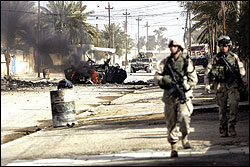The smell of war, as soldiers call it, is not just the distinct blood stench of combat but the suffocating noise, heat, and chaos of a slaughterhouse floor. Army 2nd Lt. Ben Colgan seemed to have gotten a full whiff of it when he sent an e-mail from Baghdad to his parents in Kent on Oct. 31, 2003. After months in the killing fields, “It’s getting real old and real crazy,” he wrote. A day later he was dead. Colgan, who left behind a widow and three children, appears in the new film Gunner Palace by ex-Seattleite Michael Tucker, who focuses in part on Colgan’s coincidental local roots. Colgan is also somewhat unique as the son of parents who opposed the war but lovingly supported their boy. And there is no mistaking Colgan’s special courage, said one of his commanders, Lt. Col. William Rabena. “To those of us who knew him, he was superhuman and fearless.” But what Colgan’s death also distinctly represents is the failure of modern U.S. war strategy in Iraq and, ultimately, hopes for any withdrawal soon from the “liberated” state. Despite his protective armor and the latest techniques he’d learned in 12 years of military service, 30-year-old Ben Colgan was killed by one of the oldest weapons of war, a hidden explosive—in this case a latter-day booby trap of readily available armor shells. They were set off most likely by an enemy ambusher hiding nearby with his remote detonator, a garage door opener. For the effect this homemade bomb is having on U.S. troops in Iraq, it might as well be a nuclear device.
The roadside bomb is the Iraq war’s version of the land mine or the jungle trip wire prevalent from World War I to Vietnam. It is rivaled only by the suicide bomber as a successful throwback that is destructive in Iraq. It is something else the White House and Pentagon didn’t plan for when rushing the pre-emptive strike on Saddam Hussein. The “improvised explosive device,” or IED, as the U.S. military has designated it, is not a weapon by which insurgents and other enemy forces can win the war. But it keeps them from losing it. The bomb takes an especially high toll in the street-to-street combat common in Iraq. Read through just the past month’s obituaries of American troops killed in Iraq and you will find 58 deaths, of which 16 were nonhostile. Of the 42 combat deaths, 22 were by improvised explosives—three of them killing Fort Lewis soldiers. (See “War Dead“.) One American solider died from an IED while responding to help troops wounded by another IED.
The roadside bomb leaves not just a body count but a body-parts count. Besides 1,500 dead U.S. troops, the Pentagon officially lists 11,000 troops wounded in Iraq since March 2003, a figure that excludes tens of thousand of sick and injured. Overwhelmingly, the wounded are soldiers who have lost arms and/or legs. Body armor protects their torsos, allowing more soldiers to survive blasts while leaving them limbless. As well, IEDs cause hearing loss, blindness, and brain damage, the latter being one of those unseen wounds of war that might not surface for years, affecting thousands of veterans and adding to the true, belated cost of war. In early 2004, Army Gen. John Abizaid told a House Armed Services committee: “IEDs continue to be the greatest casualty producer among our troops in the field.” Though the Pentagon promised to supply more troop training and bomb-sweep teams, IEDs are still the enemy’s No. 1 killing device. According to a January 2005 analysis by the Pentagon, obtained by The Baltimore Sun, more than half—486—of the 951 combat deaths from March 2003 through November 2004 were caused by explosives. Worse, “We’ve noticed in the recent couple of weeks that the IEDs are all being built more powerfully, with more explosive effort in a smaller number of IEDs,” said Brig. Gen. David Rodriguez during a January Pentagon briefing. He, like the generals before him, offered no solutions other than: It’s war, expect dying. The reality is that this amateurish terror concoction continues to kill most of our soldiers, just as it killed Ben Colgan 16 months ago, with no end in sight. If you see the movie, you might notice that Iraq has a weapon of mass destruction after all.








